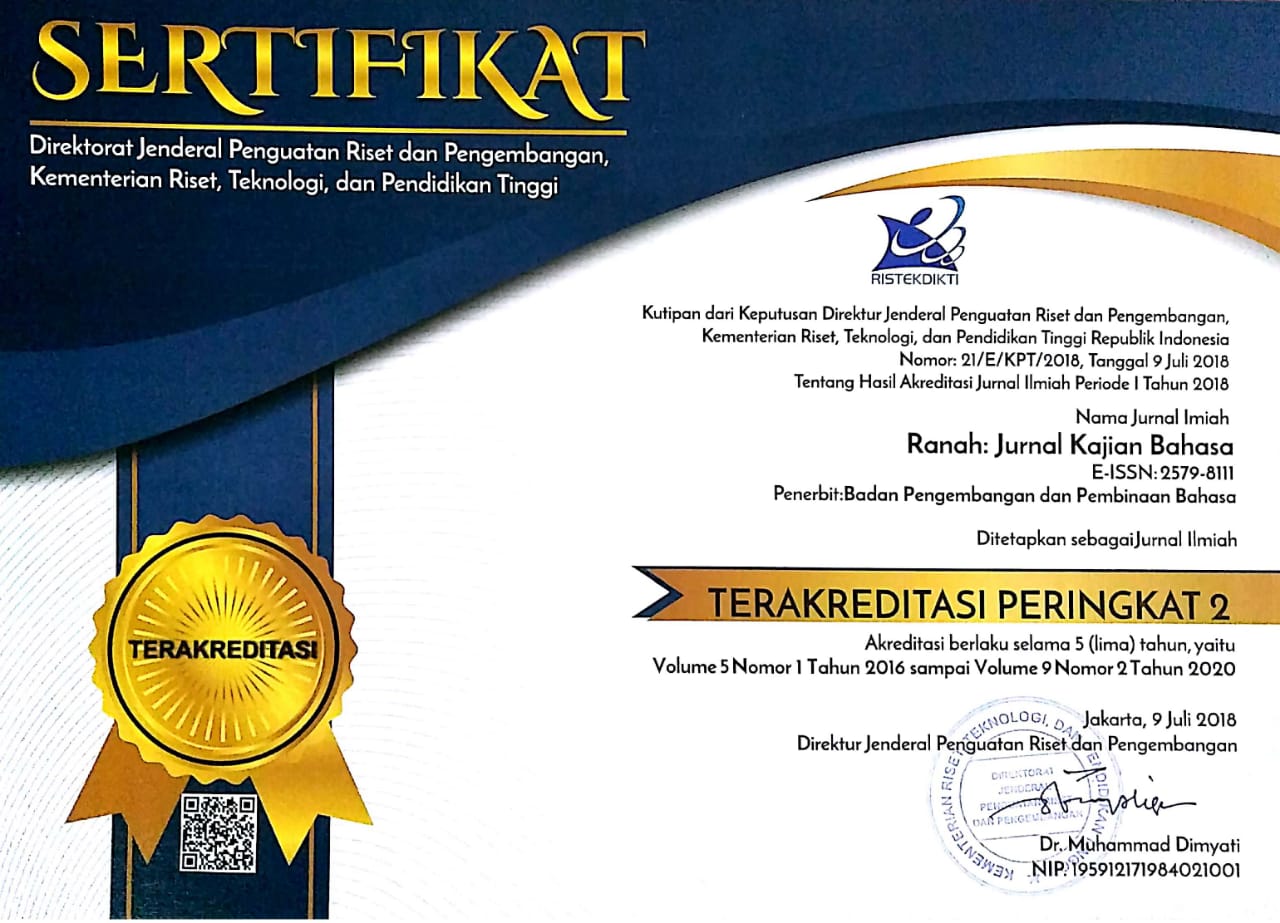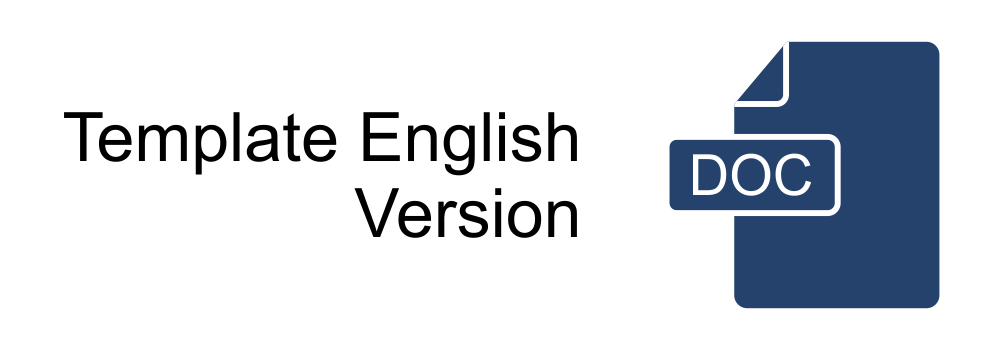Representasi Aksi Sosial dalam Konstruksi Ideologi Media Berita Digital Terkait Kebijakan Pemerintah Selama Pandemi
Abstract
In response to the Covid-19 pandemic, the government issued several policies disseminated through digital news media. However, these policies often become polemic in the community due to the different reporting based on the ideology of the media. The study aims to reveal the ideological construction of digital news media through linguistic representations of social actions in reporting on government policies during the pandemic through the employment of vocabulary and conjunctions. The data consists of digital news headlines on government policies during the pandemic generated through documentation from the three most popular digital media in Indonesia according to the Reuters Institute Digital News Report, namely Detik.com, Kompas.com, and CNN.com. The Critical Discourse concept applied is Theo van Leeuwen's social action framework to find the linguistic representation of each social action through the choice of words and conjunctions. Data analysis was carried out in two stages: analysis of the dimensions of social action to find linguistic representations of each social action in news discourse through word selection and conjunctions and ideological mapping which forms the basis of ideological classification of digital news media for every government policy related to handling Covid-19. As a result, it appears that detiknews.com does not agree with the implementation of PPKM, supports the vaccination program, and is neutral in social assistance data disputes between the central and regional governments. Kompas.com also stands in the same position on the issue of PPKM and vaccination. However, regarding the social assistance data dispute between the central and local governments, kompas.com tended to be on the government side. Meanwhile, cnnindonesia.com did not even question the PPKM-PSBB polemic, but emphasized its disapproval of paid vaccinations and sided with the central government in the social assistance data dispute between the central and regional governments.
Abstrak
Sebagai respons terhadap pandemi Covid-19, pemerintah mengeluarkan beberapa kebijakan yang disebarkan melalui media berita digital. Sayangnya, kebijakan-kebijakan tersebut tak jarang menjadi polemik karena pemberitaan yang berbeda berdasarkan ideologi yang dianut media tersebut. Penelitian ini bertujuan mengungkap ideologi media berita digital serta konstruksinya melalui representasi linguistik aksi-aksi sosial dalam pemberitaan kebijakan pemerintah selama pandemi melalui pemanfaatan kosakata dan konjungsi. Data berupa judul berita pada platform digital yang memuat kebijakan pemerintah terkait Covid-19 yang dihasilkan melalui dokumentasi terhadap tiga media digital paling populer di Indonesia menurut Reuters Institute Digital News Report, yakni detik.com, kompas.com, dan cnn.com. Konsep wacana kritis yang diterapkan adalah kerangka aksi sosial Theo van Leeuwen untuk menemukan representasi linguistik setiap aksi sosial melalui pemilihan kata dan konjungsi. Analisis data dilakukan pada dua tahapan: analisis dimensi aksi sosial untuk menemukan representasi linguistik setiap aksi sosial dalam wacana berita melalui pemilihan kata dan konjungsi dan pemetaan ideologi yang menjadi dasar klasifikasi ideologi media berita digital terhadap setiap kebijakan pemerintah terkait penanganan covid-19. Hasilnya menunjukkan bahwa detiknews.com tidak setuju dengan penerapan PPKM, mendukung vaksinasi, dan netral dalam kisruh data bansos pusat-daerah. Kompas.com juga berdiri di posisi yang sama terkait PPKM dan vaksinasi. Namun, terkait kisruh data bansos pusat-daerah, kompas.com cenderung di sisi pemerintah. Sementara itu, cnnindonesia.com bahkan tidak mempermasalahkan polemik PPKM-PSBB, menitikberatkan ketidaksetujuannya pada vaksinasi berbayar, dan berpihak pada pemerintah pusat dalam kisruh data bansos pusat-daerah.
Keywords
Full Text:
PDFReferences
Arifin, K. A., & Basuki. (2018). Media dan NYIA:(Analisis Wacana Kritis Pembangunan Bandara Baru New Yogyakarta International Airport dalam Pemberitaan Media Lokal di Yogyakarta. Jurnal Komunikasi, 13(1), 69-80.
https://doi.org/10.20885/komunikasi.vol13.iss1.art5
Bao, H., Cao, B., Xiong, Y., & Tang, W. (2020). Digital Media's Role in the COVID-19 Pandemic. JMIR MHealth and UHealth, 8(9), 1-3.
https://doi.org/10.2196/20156
Bouvier, G., & Machin, D. (2018). Critical Discourse Analysis and the Challenges and Opportunities of Social Media. The Review of Communication, 18(3), 178-192.
https://doi.org/10.1080/15358593.2018.1479881
Budhirianto, S., Noneng, S., & Syaidah. (2018). Analisis Wacana Media Terhadap Kebijakan dan Citra Pemerintah di Surat Kabar Daerah pada Tahun 2017. Jurnal PIKOM, 19(2), 101-114.
https://doi.org/10.31346/jpikom.v19i2.1607
Chaer, A. (2009). Sintaksis Bahasa Indonesia. Jakarta: Rineka Cipta.
Cissel, M. (2012). Media Framing: a Comparative Content Analysis on Mainstream and Alternative News Coverage of Occupy Wall Street. The Elon Journal of Undergraduate Research in Communications, 3(1), 67-77.
Fairclough, N. (1995). Critical Discourse Analysis: the Critical Study of Language. Londondan New York: Longman.
Fairclough, N. (2001). Discourse and Social Change. Cambridge: Polity Press.
Fathurokhmah, F. (2018). Ideologi Radikalisme dalam Islam tentang Wacana Homoseksual di Media Massa. INJECT Interdiciplinary Journal of Communication, 3(2), 193-212.
https://doi.org/10.18326/inject.v3i2.193-212
Finoza, L. (2013). Komposisi Bahasa Indonesia untuk Mahasiswa Nonjurusan Bahasa. Jakarta: Diksi Insan Mulia.
Fowler, R. (1991). Language in the News: Discourse and Ideology in the Press. New York: Routledge.
Hallin, D. C., & Mancini, P. (1985). Speaking of the President. Dalam Michel Gurevitch dan Mark R. Ley (ed.). MassCommunicationReviewYearbook. Vol 4. Mass Communication Review Yearbook: Vol.4.
Halwati, U. (2014). Membongkar Konstruksi Politik di Media Massa. JPA, 15(2), 235-257.
https://doi.org/10.24090/jpa.v15i2.2014.pp235-257
Huda, L. N. (2022). Critical Discourse Analysis of Online Media News: Ministry of Religious Affairs Banning Arabic Language. Leksema Jurnal Bahasa Dan Sastra, 7(1), 37-47.
https://doi.org/10.22515/ljbs.v7i1.4911
Jamil, A., Daniel, D., & Qassem, A. (2021). News Discourse on the 212 Social Movements: Critical Discourse Analysis on Republika and Media Indonesia. Bricolage: Jurnal Magister Ilmu Komunikasi, 7(2), 203 - 212.
https://doi.org/10.30813/bricolage.v7i2.2748
Landert, D. (2014). Personalisation in Mass Media Communication: British Online News between Public and Private (Vol. 240). John Benjamins Publishing Company.
https://doi.org/10.1075/pbns.240
Limaye, R. J., Sauer, M., Ali, J., Bernstein, J., Wahl, B., Barnhill, A., & Labrique, A. (2020). Building trust while influencing online COVID-19 Content in the Social Media World. The Lancet Digital Health, 2(6), 277-278.
https://doi.org/10.1016/S2589-7500(20)30084-4
Lubis, H. H. (2011). Analisis Wacana Pragmatic. Bandung: Angkasa.
Muslich, M. (2010). Garis-Garis Besar Tatabahasa Baku Bahasa Indonesia. Bandung: PT. Refika Aditama.
Mu'jizah, M. J., Firdaus, W., Suyatno, S., & Rohim, R. (2022). Digital Based Literature Learning Enhancement: Vista Sastra.
Nasucha, Y., Rohmadi, M. B., & Wahyudi, A. (2009). Bahasa Indonesia untuk Penulisan Karya Tulis Ilmiah. Yogyakarta: Media Perkasa.
Newman, N., Fletcher, R., Schulz, A., Andi, S., Robertson, C. T., & Nielsen, R. K. (2021). Reuters Institute Digital News Report 2021. Retrieved from https://srrn.com/abstract=3873260
Nurdin, M. H. (2020). Representasi Ideologi dalam Teks Berita Kriminal Tribun Timur: Analisis Wacana Kritis. Universitas Negeri Makassar.
Nurhusna. (2017). Penanda Kualitas Mewujud Adjektiva sebagai Ideologi dalam Wacana Iklan Advertorial Media Massa Cetak. RETORIKA Jurnal Bahasa, Sastra, Dan Pengajarannya, 10(1), 36-42.
https://doi.org/10.36277/basataka.v3i1.81
Putra, A., Cangara, H., & Darwis. (2015). Wacana Kritis Berita Online Kasus Penyadapan Pembicaraan Telepon Elit Indonesia oleh Agen Rahasia Australia. Komunikasi KAREBA, 4(1), 1-9.
Rusadi, U. (2015). Kajian Media: Isu Ideologis dalam Perspektif, Teori, dan Metode. Jakarta: Raja Grafindo Persada.
Schäfer, M. S. (2011). Sources, Characteristics and Effects of Mass Media Communication on Science: A Review of the Literature, Current Trends and Areas for Future Research. Sociology Compass, 5(6), 399-412.
https://doi.org/10.1111/j.1751-9020.2011.00373.x
Sobur, A. (2011). Analisis Teks Media : Suatu Pengantar Analisis Wacana, Analisis Semiotika, dan Analisis Framing. Bandung: PT. Remaja Rosdakarya.
Syamsul, A., & Romli, M. (2012). Jurnalistik Online: Panduan Mengelola Media Online. Bandung: Nuansa Cendikia.
van Leeuwen, T. (2008). Discourse and Practice: New Tools for Critical Analysis. In Discourse and Practice: New Tools for Critical Analysis. https://doi.org/10.1093/acprof:oso/9780195323306.001.0001
World Health Organization. (2022). WHO Corona Virus Disease(COVID-19) Dashboard. Retrieved March 28, 2022, from https://covid19.who.int/
XIe, Q. (2018). Critical Discourse Analysis of News Discourse. Theory and Practice in Language Studies, 8(4), 399-403. https://doi.org/10.17507/tpls.0804.06
Yuliantri, R. D. A., & Darmatadara, A. (2015). Political Battle of Mass Media Critical Discourse Analysis: Suara Partai Masjumi Magazine and Bintang Merah Magazine in 1951. European Journal of Interdisciplinary Studies, 2(1), 27-31.
https://doi.org/10.26417/ejis.v2i1.p27-31
DOI: https://doi.org/10.26499/rnh.v12i1.5269
Refbacks
- There are currently no refbacks.








